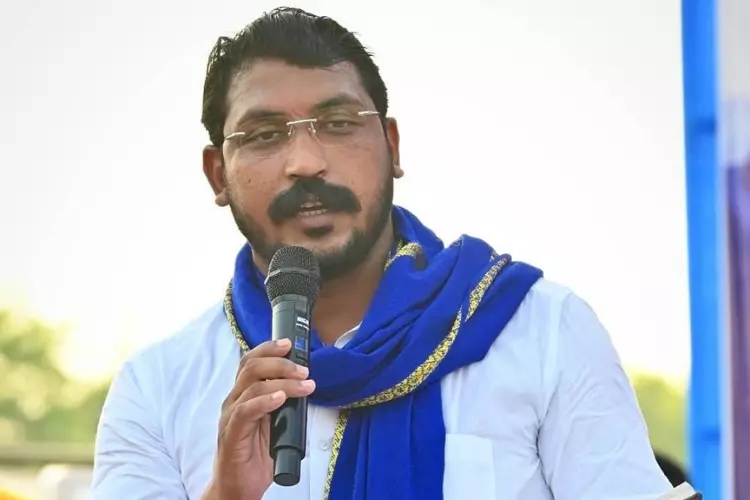NEW DELHI: Azad and Anand all set to challenge I.N.D.I Alliance.
The road to wining the upcoming byelections in Uttar Pradesh may prove to be challenging for the I.N.D.I Alliance, which put up a remarkable performance in the Lok Sabha elections in the state, by besting the Bharatiya Janata Party. The challenge is because the PDA social engineering done by Akhilesh Yadav may not work fully this time as parties such as Mayawati’s Bahujan Samaj Party and Chandrashekhar Azad’s Azad Samaj Party both eye this vote bank. And with the “threat to the Constitution”—the platform on which the I.N.D.I Alliance fought the Lok Sabha elections—a non-issue in the byelections, the PDA population may not prove to be as loyal to the Alliance any longer. And if the PDA vote bank breaks, it may be advantage BJP. So, only time will tell who the real leader of the Pichhre (Backward), Dalit and Alpsankhyak (minority), that is the PDA, will be.
ASP leader Chandrashekhar, and BSP leader and Mayawati’s nephew, Akash Anand, who has recently been appointed as the new convener of the party, have both started preparing to give a tough challenge to the I.N.D.I Alliance for UP’s PDA votes.
The first challenge will be in the byelections of 10 seats and will continue to grow. Both BSP and ASP have announced to contest the byelections on all seats. Both Azad and Anand are against the Samajwadi Party. If in the politics of Uttar Pradesh, the real struggle is for the votes of these sections. Akhilesh Yadav will no longer be able to project his SP as the leader of the PDAs. In fact one of the reasons why BJP did poorly in UP was because of Akhilesh Yadav’s social engineering with these three population segments, apart from of course internal sabotage. One of the reasons why a section of the D of PDA—that is the Dalits, gravitated towards the I.N.D.I Alliance was because of the claim that the BJP would change the Constitution and abolish reservation. However, this strategy may not work in the future as the fake threat to reservations disappears and the Dalits start looking for their own leadership.
In fact not just in UP, in Rajasthan too Congress may face some trouble, as party-supported Rajkumar Roat of Bharat Adivasi Party and Hanuman Beniwal of RLP both won the Lok Sabha elections and are steeped in caste politics and have the potential to attract a large section of PDA voters.
Rajkumar’s party is demanding the creation of Bhil Pradesh, laying claim to the tribal areas traditionally considered strongholds of the Congress party. The “BAP” party is eyeing for control in these regions. Similarly, Beniwal, who identifies as a leader of the Jats, claims that Congress’ victories in Jat-dominated states are because of his influence. Both leaders are eyeing the five vacant Assembly seats where byelections will be held, which could pose significant challenges for Congress in the future. If these two leaders decide to join the BJP, it could provide some relief for Congress; otherwise, its troubles are likely to escalate.
In Uttar Pradesh, the ASP and BSP are focusing on winning over Dalit and Muslim voters. During the 2019 Lok Sabha elections, BSP secured ten seats in Dalit and Muslim-dominated areas. However, this time, votes from these communities have shifted to the I.N.D.I Alliance and Azad’s party. Following the election results, Mayawati has reappointed her nephew Akash, known for his aggressive speeches, to a leadership role. Experts believe Akash could revitalize the party, with BSP’s main target being SP.
Meanwhile, Chandrashekhar Azad’s victory as an independent in the Nagina Lok Sabha seat has sent a strong message to the I.N.D.I Alliance. Despite the I.N.D.I Alliance’s best efforts, its candidate came third, with the BJP finishing second. Chandrashekhar, who had sought support from the I.N.D.I Alliance, but was refused by Akhilesh, has emerged as a significant Dalit leader, much like Mayawati did after winning the Bijnor Lok Sabha seat in 1989. His organizational strength is growing as workers from other parties join him. With strong support in western Uttar Pradesh, he is preparing for the 10 vacant Assembly seats that are going to the polls. His focus is on the Backward Classes, Dalits, and minorities—the PDAs. His strategy includes focusing on Muslim voters while being confident of Dalit support, which evident from his inclusion of Muslim faces in his organization.
Chandrashekhar’s aggressive approach, similar to Mayawati’s early political style, was clear during the oath-taking ceremony in the Lok Sabha. His ambitions extend beyond Uttar Pradesh to all Hindi belt states. Last year, he contested the Rajasthan Assembly elections in alliance with Beniwal’s RLP, causing losses for Congress. Now he is fully concentrating on Uttar Pradesh, strategizing for the Assembly elections set to take place in 2027.
For the BJP, the rise of Chandrashekhar and Akash could weaken the I.N.D.I Alliance, allowing the BJP to focus on upper castes and OBCs. Congress’ stance on the Constitution and reservation is distancing it from the upper castes. It’s unlikely that Rahul Gandhi will abandon his caste politics, even

